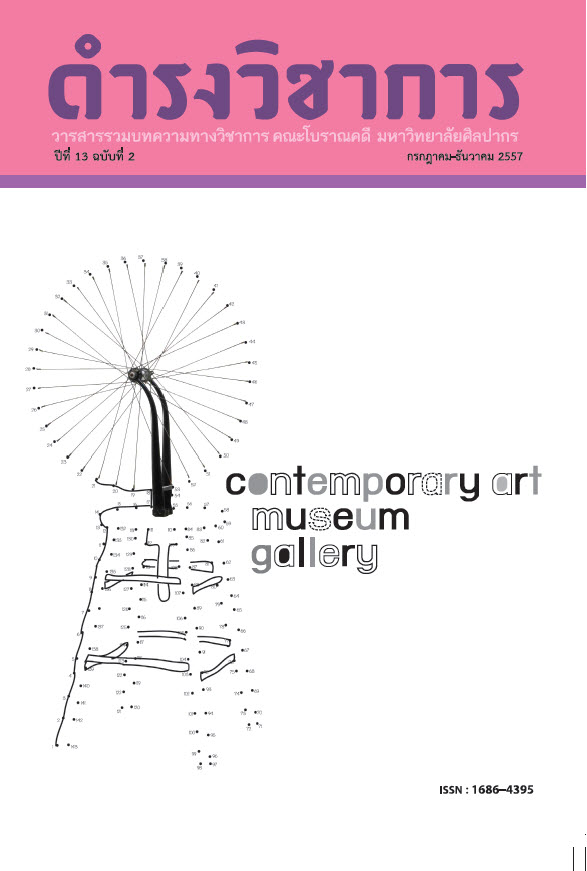Styles of Vietnamese Influenced Ordination Hallsin Northeast Siam and the Development of the Artwork
Keywords:
Vietnamese ordination hall, Northeast, Development of the artworkAbstract
Recent research has found that the appearance of the Vietnamese influence in the artwork of Northeastern Thailand occurred during a period which was witness to poor economic conditions. As such, a religious construction in a large community was supported by fundraising in order to hire the construction workers, who were often Vietnamese. Due to the political conditions at the time, the central administration of the government of Siam had no influence over the construction of ordination halls in the Northeast of Siam until Field Marshal Plaek Phibunsongkhram came into power. As such, important cities and main districts had to follow the political policy of the central government which was reflected in all sacred, religious and cultural places that they built.
Due to the fact that the Vietnamese were employed as a skillful labour force, they inserted their own faith, beliefs, and moral precepts into the buildings they worked on. One of the most outstanding techniques employed by the Vietnamese workers was a pattern found on the top of the wall of the structure where it meets the roof in many Vietnamese influenced ordination halls. However, other decorations exist according to the trends of each period. From 1900–1967, the patterns from Vietnamese influenced ordination halls were obvious and of an outstanding quality in the Northeast of Siam and it is said that this architectural style is now an integral part of Buddhist architecture in the Northeast of Siam.
References
กรมการศาสนา, 2555. เสนาสนะ. กรุงเทพฯ: การศาสนา.
กรมศิลปากร, 2555. แบบอุโบสถ. ค้นเมื่อ 22 มิถุนายน, จาก http://www.dpt.go.th/download/PW/religion/b01.php
กระทรวงมหาดไทย, 2554. แบบศาสนสถาน. ค้นเมื่อ 17 กุมภาพันธ์, จาก http://www.thaiarch3d.com/chapel5.html
ขจัดภัย บุรุษพัฒน์, 2541. ญวนอพยพ. กรุงเทพฯ: ดวงกมล.
ชวลิต อธิปัตยกุล, 2556. “อาคารแบบอาณานิคมริมฝั่งแม่น้ำโขง.” เมืองโบราณ. 39 (2): 87-89.
ชวลิต อธิปัตยกุล, 2552. รูปแบบอุโบสถในจังหวัดอุดรธานีช่วง พ.ศ. 2511-2530 กับการสืบเนื่องทางงานช่าง. วิทยานิพนธ์ปริญญาปรัชญาดุษฎีบัณฑิต สาขาประวัติศาสตร์ศิลปะไทย บัณฑิตวิทยาลัย มหาวิทยาลัยศิลปากร, กรุงเทพฯ.
ดิลก ตีระวนิช, 2551. หัวหน้าฝ่ายออกแบบและก่อสร้าง กองพุทธศาสนสถาน สํานักงานพระพุทธศาสนาแห่งชาติ. สัมภาษณ์, 24 พฤศจิกายน.
เดือนเพ็ญ ทองน่วม, 2543. หน้าต่างสู่โลกกว้าง เวียดนาม. กรุงเทพฯ: หน้าต่างสู่โลกกว้าง.
เติม วิภาคย์พจนกิจ, 2546. ประวัติศาสตร์อีสาน. กรุงเทพฯ: ธรรมศาสตร์.
ธรรมะไทย, 2557. ประวัติพระพุทธศาสนาในเวียดนาม. ค้นเมื่อ 7 มิถุนายน, จาก http://www.dhammathai.org/thailand/missionary/vietnam.php
ธีรชัย บุญธรรม, 2542. ประวัติศาสตร์สังคมอีสานตอนบน พ.ศ. 2318-2450. มหาสารคาม: มหาวิทยาลัยมหาสารคาม.
พรพรรณ จันทโรนานนท์, 2530. ฮก ลก ซิ่ว ลาภ อายุยืน. กรุงเทพฯ: มติชน.
ศักดิ์ชัย สายสิงห์, 2555. เจดีย์ พระพุทธรูป ฮูปแต้ม สิมศิลปะลาวและอีสาน ประมวลศิลปกรรมโบราณทุกแขนง ทั่วเวียงจันทน์ หลวงพระบาง อีสาน. กรุงเทพฯ: มิวเซียมเพรส.
สมใจ นิ่มเล็ก, 2547. อุโบสถ สถาปัตยกรรมไทย. กรุงเทพฯ: ด่านสุทธาการพิมพ์.
สมเด็จพระมหาสมณเจ้า กรมพระยาวชิรญาณวโรรส, 2514. วินัยมุข เล่ม 3. กรุงเทพฯ:มหามกุฏราชวิทยาลัย.
สันติ เล็กสุขุม, 2546. “อนุรักษ์และสืบทอด” ลีลาไทย เพื่อความเข้าใจความคิดเห็นของช่างโบราณ. กรุงเทพฯ: มติชน.
สันติ เล็กสุขุม, 2550ก. การอนุรักษ์กับพัฒนาตรงข้ามกันจริงหรือ. บรรยาย: มหาวิทยาลัยราชภัฏอุดรธานี, 9-10 ตุลาคม.
สันติ เล็กสุขุม, 2550ข. สัมมนาวิชาศิลปะไทย, สาขาประวัติศาสตร์ศิลปะไทย. บรรยาย: คณะโบราณคดี มหาวิทยาลัยศิลปากร, 20 ธันวาคม.
สันติ เล็กสุขุม, 2551. อาจารย์พิเศษสาขาประวัติศาสตร์ศิลปะไทย คณะโบราณคดี มหาวิทยาลัยศิลปากร. สัมภาษณ์, 26 สิงหาคม.
อนุวิทย์ เจริญศุภกุล, 2530. “จุดเด่นในงานสถาปัตยกรรมอีสาน.” หน้าจั่ว 7: 21.
Downloads
Issue
Section
License
บทความนี้เป็นผลงานของข้าพเจ้าแต่เพียงผู้เดียว และ/หรือเป็นผลงานของข้าพเจ้าและผู้ร่วมงาน ตามชื่อที่ระบุในบทความจริง และเป็นผลงานที่มิได้ถูกนำเสนอหรือตีพิมพ์ที่ใดมาก่อน





